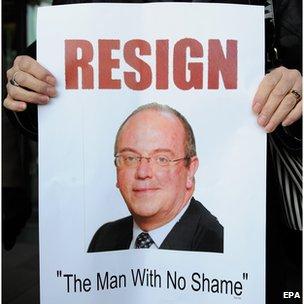Why the writing was on the wall for Sir David
- Published

Sir David has been under pressure since the Stafford Hospital report was published
The moment the public inquiry into the Stafford Hospital scandal was published on 6 February it was clear retiring England NHS boss Sir David Nicholson was in trouble.
Neither the report or chairman of the inquiry called for his resignation.
But there was enough in the 1,700 pages to make life extremely uncomfortable for him - particularly with the Daily Mail dubbing him the "Man with No Shame"
Firstly, the report was scathing about the culture in the NHS, saying it put "corporate self-interest" ahead of patients over the failings, which led to hundreds of needless deaths because of neglect and abuse.
As head of such an organisation, Sir David clearly had a case to answer.
But it went further than that.
The inquiry also dealt with his time as head of the health authority which oversaw Stafford Hospital.
He was on the panel that appointed Martin Yeates as Stafford's chief executive, the individual who ordered the cost-cutting measures which led to the "appalling" standards of care.
Over the next few months documents show that Sir David was concerned about the performance of the trust, but letters from the hospital's bosses convinced him they were tackling the problems.
The inquiry suggested this could have been viewed as the trust being in denial rather than engaged with the difficulties.
Passionate
Questions were also asked over why there were no objections over the decision to recommend Stafford for elite foundation trust status in the summer of 2007 when it went through the Department of Health validation process.
He was, by this point, the department's most senior civil servant.
He is also reported to have dismissed Cure the NHS, the campaign group set up by local Stafford Hospital patients, as "simple lobbying" in a meeting with the NHS regulator in 2008.
The findings were enough to prompt campaigners and MPs to call for his head.
The government resisted, saying he was the right person to lead the NHS.
At the time, the health service was little over a month away from the biggest reorganisation in its history.
Close to ministers
It is also likely ministers felt a great deal of loyalty to Sir David.
Over the past two years he has developed a close working relationship with Number 10 - so much so that it was Sir David rather than Andrew Lansley that the prime minister turned to most when the NHS reforms were nearly derailed by opposition within the health service.
Sir David has also proved extremely effective at keeping a tight control on the purse strings.
When he took over in 2006, NHS trusts were running up deficits.
He enforced tighter fiscal management by keeping a firm grip - some would say too firm - on what the NHS was up to.
In fact, a sign of his control can be seen in the fact that the latest savings drive - the bid to save £20bn by 2015 - is known as the "Nicholson challenge".
But this focus on spending led to accusations he was too controlling and at times bullying.
Many will argue this is an inevitable for someone who is a leader of an organisation the size of the NHS - it has 1.3m staff and a turnover of more than £100bn.
And those who have worked closely with him describe him as being a passionate and caring man.
But despite all his success during his 35-year NHS career, for many he will be known as the man who was in charge when the NHS forgot to care.